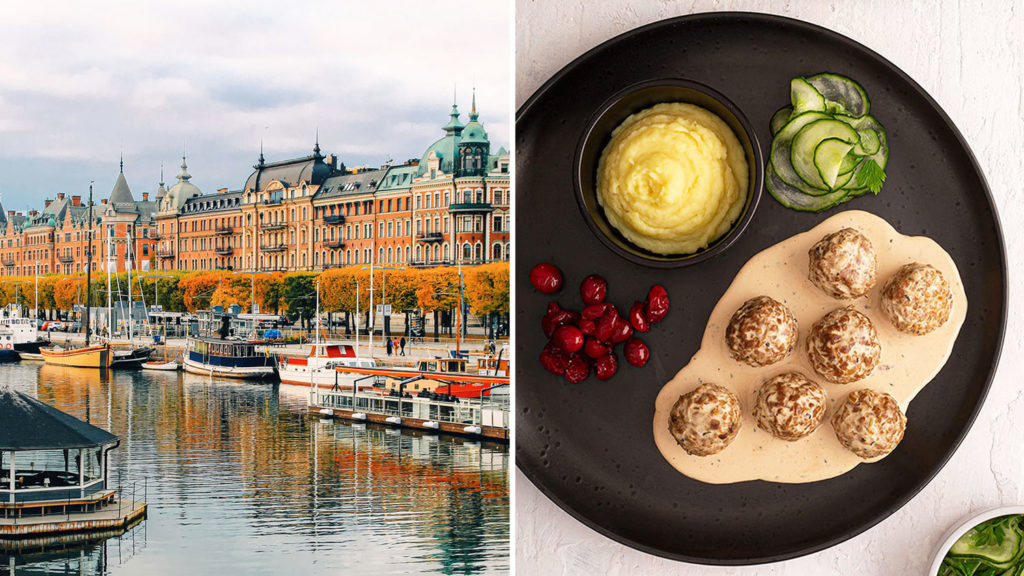Swedish meatballs, or köttbullar, are a staple on every Swedish table, and not just during the holidays, though they are an essential part of a holiday smörgåsbord such as the julbord (Christmas spread). “It’s traditionally what we call husmanskost, which means home cooking. It’s a dish that’s served in every Swedish family,” says Swedish chef, restaurateur, and cookbook author Anna Bonde-Mosesson. “It’s a dish that’s ultimately Swedish completely and utterly.” Meatballs are so integral to Swedish cuisine that they even have their own holiday: Meatball Day, or Köttbullens dag, on August 23rd.
For many, meatballs are associated with home. “It would be very unusual if you went to a Swedish family and they didn’t eat meatballs at least once a week,” says Bonde-Mosesson, adding that kids eat them from infancy. “You always have a pack in the freezer, unless you have a grandmother who makes some freshly for you,” she explains. “If you’ve been out for a long walk and you can’t be bothered to cook, you’ve got those meatballs in the freezer, you just get them out straight into the frying pan, and you’ve got a delicious meal.”
They’re eaten from the frozen edges of Sápmi to the capital city of Stockholm. But where did Swedish meatballs come from, and how did the dish get to be so ubiquitous with its country of origin?
Surprisingly, what’s now known as the Swedish meatball probably came from significantly warmer climes. In the early 1700s, a young King Charles XII of Sweden traveled throughout much of western Europe, defending his kingdom’s borders and empire building. He spent five years in the Ottoman Empire, now Turkey and Moldova, and developed a taste for the food. He is credited with bringing back not only meatballs, based on Turkish köfte, but also coffee and kåldolmar, stuffed cabbage rolls. “The first mention of meatballs was in 1755 in Kajsa Warg’s cookbook Hjelpreda I Hushållningen För Unga Fruentimber (“Guide to Housekeeping for Young Women”),” says Argot Murelius, Swedish food writer and editor.
They’ve been on Swedish tables ever since. Long dark winters mean that Sweden has a culinary tradition of hearty and preserved foods, and meatballs certainly fit the bill. “It’s a comfort food,” says Bonde-Mosesson. “It’s an everyday food.”
Meatballs are so integral to Swedish cuisine that they even have their own holiday.
There’s no single recipe for meatballs—each family has its own take. It’s generally agreed that there’s minced meat, usually beef and/or pork, breadcrumbs soaked in milk, onion, salt, black pepper, and allspice. The consensus is that they are served with a sauce, usually a cream gravy; mashed potatoes; and lingonberries (a small, sour red berry similar to a cranberry). They may also be served as a street food “with pickled beetroot and mayonnaise on a piece of bread as a sandwich,” says Bonde-Mosesson.

“As for its place on the Stockholm food scene, meatballs are found on most menus in traditional restaurants,” says Murelius. “If you ask die-hard Stockholmers, a large portion of them would say that the classic old haunt Prinsen makes the best meatballs. The meatballs at Operabaren and Bakfickan are legendary too.”
Traditional though they may be, Sweden’s meatballs aren’t stuck in the past. Thirty percent of Swedish millennials are eating more plant-based foods for environmental reasons, and Stockholm’s plant-based meatball scene is thriving. Popular restaurant Meatballs for the People in the trendy Södermalm neighborhood serves 14 varieties of organic meatballs, including vegan meatballs. IKEA, Sweden’s famous retailer, debuted a vegetable ball in 2015, but 2020 saw the additional release of a new “plant ball,” a vegan version that cleaves more faithfully in taste to the original. With the increasing variety of plant-based meats on the market, creating vegan meatballs at home is easier for home cooks, too.
They may be on to something. “There are 249,000 hits on Swedish Google for vegan meatballs,” says Murelius. “Swedes are pretty open-minded when it comes to Meatless Monday and all that. Loads of people keep a pretty meat-free lifestyle.” Stay tuned for the plant-based meatball revolution.
How to make plant-based Swedish Meatballs
Chef Ankan Linden created this plant-based Swedish meatball recipe using Oumph! Mince as a meat substitute.


